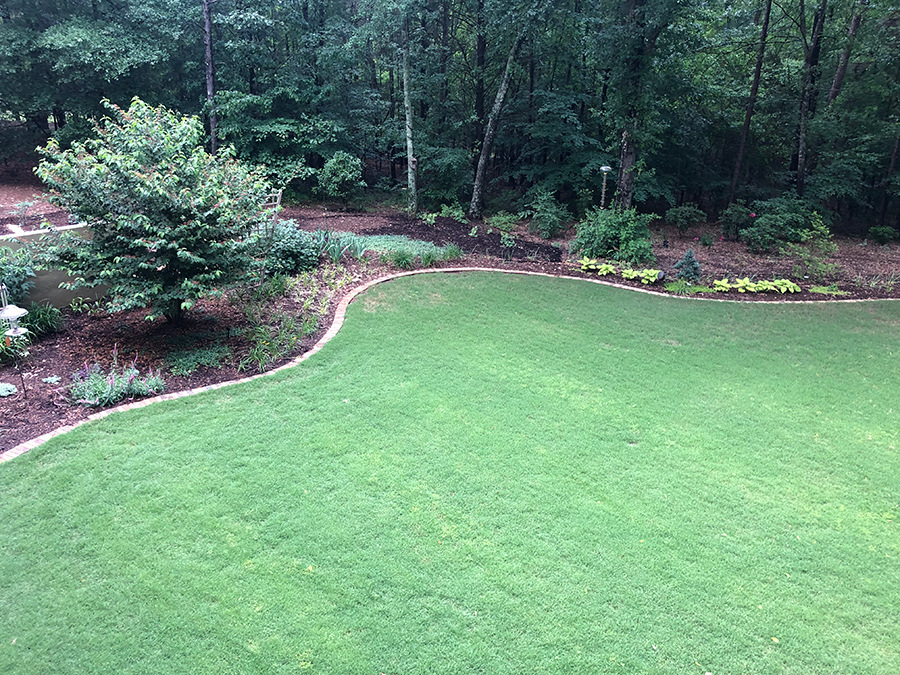

Lawn Border Edging: A Guide to the Finishing Touch for Lawns


This simple yet often overlooked design feature dramatically improves the appearance of any lawn: border edging.
Good lawn border edging elevates your garden’s overall aesthetic, keeps your lawn in check, and makes lawn care, such as maintaining clean, defined lines, much more manageable. Edging is the finishing touch that gives your turf a “frame” and helps it stand out from the rest of your landscape.
"Thin stack" stone edging frames this small Zoysia lawn.
Since I adore bullet points for webpage skimming, let’s start with a list of why edging matters in the first place:
- Enhanced Design Aesthetic:
- Edging allows you to play with shapes, colors, and materials, enhancing the overall design of your landscape.
- Clean and Crisp Appearance: A well-edged lawn looks neat and tidy. It gives your yard a professional finish, even if your garden is simple.
- Increased Property Value: A well-landscaped yard with clear boundaries and clean lines adds curb appeal, positively impacting property value.
- Reduced Lawn Maintenance and Weed Control: Lawn border edging helps reduce maintenance time spent trimming and weeding by keeping grass from invading flower beds or vegetable patches.
Lawn border edging is any material used to create a defined boundary between your lawn and garden beds. These edges aren’t just about appearances—although they significantly enhance a yard's visual appeal—they also serve a practical function. By creating a physical barrier, edging prevents grass from spreading into garden beds and stops soil and mulch from spilling onto your lawn. Well-executed edging brings order and structure to your outdoor space, giving it a polished, intentional look.
In this article, we'll discuss everything you need to know about choosing lawn border edging for your landscape: the types of materials, a brief overview of how to install them, and the benefits they bring to your garden design.
Types of Lawn Border Edging Materials
Choosing the material for your edging depends on the look you want to achieve, your budget, and how much maintenance you’re willing to commit to. Here’s a breakdown of the most popular lawn border edging materials.
Natural Lawn Border Edging
- Lawn Trenches: For those who prefer a natural look, a simple trench between the lawn and garden provides a clean, natural edge. A trench is low-maintenance and cost-effective but requires occasional upkeep to maintain its depth and crisp lines. It's perfect for informal gardens where a more natural boundary is desirable. This type of edging requires only a shovel and sweat equity – no purchase of materials to install is required. The picture in the header shows crisp, clean lawn trench
A lawn trench is a traditional and affordable solution, but it does require regular maintenance to keep a crisp, sharp edge.
- Wood Edging: Using twigs, branches, logs, or planks to edge a garden can give a rustic or cottage-like feel. Cedar is naturally resistant to rot and can last for years without treatment. However, wood will eventually degrade, especially in moist environments, so it's not as permanent as stone or metal. Treated wood resists rot and weather damage, making it a more durable option, but it has less of a rustic vibe.
- Living Edging: For a softer, more natural approach, plants can act as an edge. Low-growing plants such as monkey grass (Liriope), mondo grass, dwarf boxwoods, or even flowering annuals and miniature hostas and ferns can define the boundary between your lawn and garden beds. Living edging adds color and texture to the landscape but may require regular pruning to keep larger plants in check.
A low boxwood hedge makes a classic lawn border that lends a formal air. This lawn border edging combines the trench method with living plants.
- Mulch: Wood chips and pine straw can create a soft, natural boundary between lawn and garden beds. These materials blend seamlessly with most garden styles and provide the added benefit of improving soil moisture retention and suppressing weeds. While mulch and pine straw may need periodic replenishing, they offer an affordable and eco-friendly option for defining garden borders. This type of edging works particularly well in informal gardens and woodland landscapes, giving a more natural look.
Monkey grass combined with pine straw does the trick for providing a border around this Bermuda lawn, plus the pine straw double as a mow strip.
- Stone Edging: Natural stones, such as flagstones, cobblestones, boulders, capstones, rubble strips, or river rocks, lend a weighty, significant feeling to landscapes. Stones are durable and weather-resistant, making them an excellent choice for long-term edging. They can be arranged in various ways, from tightly stacked stones for a formal look to more scattered arrangements for a casual, natural appearance.
Rubble strip stone lawn edging comes in natural, as show in this picture, or gray. We sell rubble strip at our stores - call or come by to order.
Manufactured Lawn Border Edging
- Plastic and Vinyl Edging: These are some of the most affordable options on the market. Plastic and vinyl are flexible, easy to install, and readily available at local big box stores in various styles and colors. While they provide a clean look, these materials lack durability over time and may fade or crack with exposure to the elements.
Plastic edging, sold in rolls, is readily available from "big box" stores.
- Metal Edging: Sleek and modern, metal edging creates a minimalistic and sharp boundary. It is highly durable and long-lasting, making it ideal for high-traffic areas for homeowners seeking a contemporary design. However, metal edging can be more expensive than other materials, it's harder to install due to its weight and rigidity, and may require professional assistance. There are black and green options at local big box stores, or a core-ten steel edging with a modern rusted look is available online.
Metal edging on the left of me; stone edging on the right. (Here I am, stuck in the middle with you. 🎶)
- Concrete, Brick, and Manufactured Stone Edging: If you want a more formal or structured look, concrete or brick borders are excellent choices. These sturdy materials withstand heavy foot traffic and are great for defining pathways, flower beds, and driveways. Brick and concrete edging are good for creating curves and geometric shapes in a landscape, offering versatility along with durability.
A single line of brick.
A brick path that doubles as a beautiful Zoysia lawn frame.
Creative Lawn Border Edging Ideas
- Mixed Materials: Blend different edging materials, such as stone and metal, to create a dynamic look that adds depth and texture to your garden design.
- Mixed Sizes: Blend stones of different size, such as placing boulders in mixed river rocks or using different sizes of river rock.
Mixed sizes of river rock - we sell river rocks, so call or come by for prices.
- Lighted Edging: Incorporate solar-powered or LED lights along the border to create a striking nighttime display and improve safety along pathways.
- Pathway Edging: It’s perfectly acceptable to double-duty a stone pathway as a lawn border edging. Instead of just a thin stone border, widen it to make a path that's a comfortable width for a person walking single-file and carrying bags, boxes, luggage, etc.
Rustic modern cottage with pathway/mow strip around the house (and an outdoor shower!). We sell flagstone and river rock, as seen in this picture.
- Mow Strip: An underrated design feature is the utilitarian mow strip. The idea is to border the lawn with flat stone, brick, or concrete and position it flush with the lawn. These strips allow you to run one side of your mower over the stones, thereby mowing the grass tufts that develop along the edge without needing to trim flowering plants to get them out of the mower’s way. Mow strips provide a clean, structured look while also reducing maintenance time. I regret not installing a mow strip at my new house (I know better!). It does make mowing and edging a lot easier.
This stone is "thin stack" used as a low dry-stacked wall and mow strip. We also sell it - please call ahead to order.
- Curved Edges: To add visual interest, create curved or wavy borders instead of straight lines. Curves soften the look of a garden and can make a small space feel larger.
Talk about a curvy frame! This creative gardener placed a blend of "pond mix" and "medium stack" stones as a simple stone lawn border that includes bare mulch as a mow strip. We sell these types of stone too.
Eco-Friendly Lawn Edging Options
- Repurposed Materials: For a unique, eco-friendly edge, try using broken pottery, upside-down bottles, recycled bricks, repurposed wood, and other upcycled materials.
- Recycled Plastic or Rubber Edging: Made from recycled materials, these options offer durability and sustainability.
- Permeable Borders: Gravel, mixed sizes of river rocks, mulch, or plant borders create a natural edge and reduce water runoff by facilitating slow percolation into the soil. A natural trench border is a low-cost option that facilitates soil recharging with water.
Wood chips from a local arborist suffice as a lawn border edge and protect flowering plants from getting mowed.
- Sustainably Sourced Wood: Use untreated, naturally rot-resistant wood like cedar to create an environmentally friendly garden edge that will biodegrade. When branches and twigs fall from trees, use them to line your beds – this practice reduces landfill waste and allows the nutrients in those branches to cycle back into your landscaping. Likewise, simply use mulch in the bed to give it a clear boundary between flowering plants and your lawn, as described under the natural lawn border section above.
Use fallen twigs to make an English cottage style lawn border.
Lawn Edging Considerations
When it comes to choosing the right edging for your landscape, consider several factors:
- Style and Design: What look are you going for? For a traditional English garden, brick or stone might be the best option. For a more contemporary landscape, metal might be your material of choice. For cottage gardens, natural materials and upcycled edging make them feel homey. Whatever your style, match your edging to the overall design aesthetic of your home and garden.
- Durability: If you want something long-lasting, materials like stone, brick, concrete, and metal are better suited than plastic or wood. Be sure to choose materials that withstand your local climate and soil conditions.
- Budget: Cost is an important factor. While plastic edging is budget-friendly, stone and metal come at a higher price but provide greater longevity. Make sure you balance cost with the expected lifespan of the material.
- Ease of Installation: If you're a DIY enthusiast, plastic, vinyl, or simple stone borders might be manageable. However, materials like metal and concrete often require professional help for proper installation.
Manufactured "rumble wall" from Keystone provides an easy lawn border edging due to consistency of size. We don't sell Keystone online, but all our stores have it for pickup or delivery.
General Installation Tips for Lawn Border Edging
Tools Needed: Common tools include edging shovels, trenching tools, string lines, levels, and mallets.
The installation process is crucial in getting clean, professional results regardless of the material. Here’s a simplified guide for installing lawn border edging (varies by material used):
- Preparation: Once you have decided where you want your edge, mark the edge using string, spray paint, or garden hoses to create a guideline, ensuring your edges are straight or your curves are smooth. Then, measure the linear footage of where you want to place your edging.
- Digging the Trench: Dig a trench along your marked line to the appropriate depth based on the height of your edging material. The trench should be deep enough to bury part of the edging so it remains stable.
- Installing the Edging: Place the edging material in the trench, making sure it is level and follows the contour of your lawn. For flexible materials like plastic or vinyl, use stakes to secure the edging in place. Heavier materials like stone, brick, or metal may not require as much reinforcement but should be set evenly and firmly, perhaps with a foundation base in gravel or concrete. Ensure proper spacing and alignment to keep edges looking clean and professional.
- Backfilling: Once the edging is in place, backfill the trench with soil or mulch to hold everything in place. Pack the soil tightly to prevent shifting over time.
Maintaining Your Lawn Border Edging
Just like any other part of your landscape, your lawn edging needs regular maintenance to stay in good condition. Here are a few tips to keep your edges looking sharp year-round:
- Regular Trimming: Whether you're using natural or manufactured materials, keep the grass and weeds from creeping over the edge. String trimmers or manual edging tools work well to maintain clean lines.
- Growth Regulators: Spraying a turf growth regulator, such as “Edgeless,” will help reduce the need for frequent trimming along your lawn borders. These products work by slowing the growth of grass around your edging, preventing it from overgrowing into garden beds or paths. By reducing turf growth, you can keep your edges looking clean and tidy for longer periods, saving time and effort in regular maintenance.
- Cleaning: Different materials need different levels of upkeep. For example, stone or brick borders may need periodic cleaning (pressure washing) to remove algae or mildew. Metal edging can sometimes rust, especially in wet climates, and may need occasional rust-removal treatment to maintain its appearance.
- Checking for Shifting or Damage: Over time, edging can shift due to frost heave, roots, or soil movement. Inspect your borders yearly to ensure they remain properly aligned and make adjustments as necessary.
Common Mistakes to Avoid
When installing lawn border edging, there are only a few mistakes that can detract from the final look:
- Uneven Installation: Make sure to keep your edging straight or evenly curved. Uneven lines will look unprofessional and may require reinstallation.
- Choosing the Wrong Material: Be sure to pick a material that fits the climate and conditions of your yard. For example, wood can rot in very damp environments, and plastic may not hold up in areas with extreme temperature fluctuations.
- Neglecting Maintenance: Even the best-installed edging needs upkeep. Regular trimming, cleaning, and adjusting will keep it looking its best.
Keep in mind that plans change over time, too. Personally, I started with a trench border due to the lower cost and ease of implementation. Years later, I saw a stone border on a garden tour that wowed me, so I saved up and copied that idea. (Garden tours are great for getting ideas!)
Whether you’re installing new edging or updating old borders, I hope this article inspires you to give your lawn the frame it deserves.
Boulders and mixed river rock lining a lawn at our Dawsonville, GA store.
We sell all sorts of stone by the pallet, including this cobblestone. Call or come by to learn what we can order for you.
All pictures by Hillary Thompson and Daniel White (Atlanta regional manager). In other words, no purchased stock art was used!




